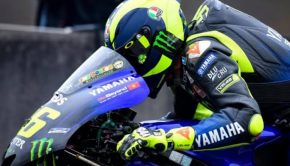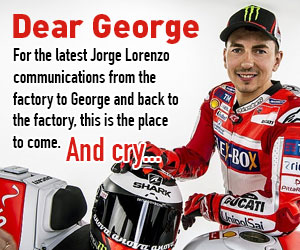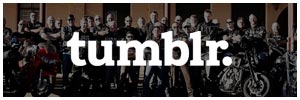CARAMELLO THE CLOWN AND HIS AMAZING MOTORCYCLE CIRCUS

We think Caramello is the bald one in the red outfit behind the elephant
At Phillip Island the MotoGP world championship was turned into a circus.
Fast, loud and expensive, but a circus nonetheless. At the head of this circus is a bald, bespectacled Spanish clown called Caramello. His Dorna circus was yet another demonstration of the governing body’s complete inability to manage a championship of this scale.
The MotoGP script is perfectly prepared before commencement of the season. Rules and technical regulations are reviewed, debated, negotiated and codified in a painstaking process. The Australian MotoGP on Sunday proved that if the show deviates even slightly from the script, a clusterfuck inevitably ensues.

“The mistake? It was only this big.”
What happened at Phillip Island was not just a single mistake, it was an unprofessional cock-up by Bridgestone which precipitated a series of blunders by Dorna, highlighting its inability to deal with change, crisis, or unforeseen situations. Bridgestone dropped the ball, but Dorna completely screwed it up from there.
The panic that set in when Bridgestone realised their tyres would not last race distance set off a sequence of stuff-ups that dramatically changed the face of this year’s championship. What resulted was not a MotoGP. It was neither MotoGP length, nor consistent with the purpose of a motorcycle Grand Prix. It was a joke, and full championship points should not have been awarded for it.

A labour of love and brilliance
The riders’ reaction to the new surface was overwhelmingly positive. Not only was the quality of the surface celebrated for removing the pre-existing bumps and undulations, but the level of grip offered received high praise from the world’s best riders. However, at some point while the riders were singing its praises, Bridgestone engineers realised their tyres were not capable of dealing with the performance of the motorcycles and the quality of the track surface. What makes that so unprofessional is that they were entirely unprepared for that eventuality, despite the fact this surface was laid in December 2012. In the 10 months of its existence, Bridgestone made no attempt to test on it. World Superbikes raced on the new surface in February without incident, though on Pirelli rubber. Yes, their races are different. Yes, WSB racing places less load on a tyre than a prototype MotoGP bike. But Pirelli provided WSB with a tyre that met the requirements of its category. Bridgestone did not. I am reliably informed by the man who oversaw the resurfacing of the Phillip Island Circuit last year that the surface is a proprietary mix, engineered for maximum performance. The mix is of the highest Polished Aggregate Friction Value (PAFV) in the world; something Bridgestone would know if it had consulted the company that laid it, which is the least you would expect it to do if it didn’t intend to test on it. It did not. Apparently, it was not interested in investigating what level of grip was engineered into the state-of-the-art track surface. What it did instead was arrive with a shipping container full of complacency and unsuitable racing tyres.
Bridgestone is not merely a company that brings tyres to the track. As the sole supplier of the category’s control tyre, it is a commercial partner of Dorna. The lengths Dorna went to this weekend to conceal Bridgestone’s incompetence is concerning, because ultimately it showed it was prepared to sacrifice the integrity of MoytoGP racing to accommodate the incompetence of a commercial partner.
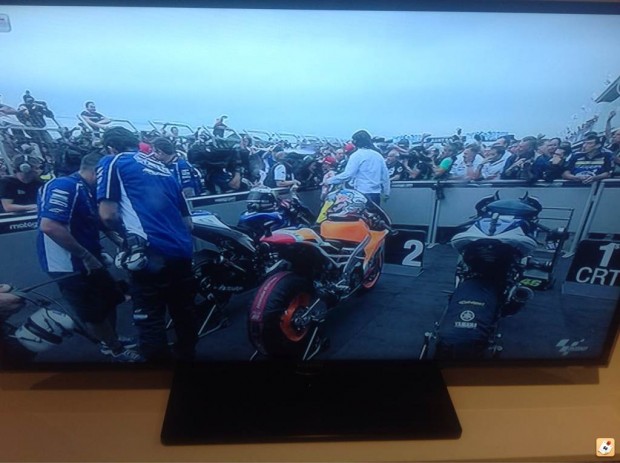
So why would they fit tyre-warmers to the tyres AFTER the race?
Tyre management is a considerable factor in racecraft. It is part of the essence of motorsport; he who can make most effective use of his machinery wins the race. Or, to borrow from Fangio, “To finish first, you must first finish”. That includes consumables such as fuel and tyres. Lorenzo has a more clinical and conservative riding style than both Marquez and Pedrosa. Maybe he would’ve conserved his tyres better than the more aggressive Honda riders and passed both in the closing laps and won the race. Maybe Marquez’ freakish talent would’ve allowed him to ride the bike sideways to win the race, as Anthony Gobert did in the WSB race in 1996. Both championship contenders were deprived of that chance. We, the paying customers, were deprived of the chance to see it. What we got instead was a glorified version of a two-part sprint race, the sort of thing you’d expect to see in local club racing. Spectacular maybe, but not a MotoGP.
How is it possible that an organisation such as MotoGP, a world championship that has been operating in excess of 60 years, with the mammoth capital investment and technology involved, be redefining its race distance and regulations in the hours before the flag is due to drop? Fundamentally, Dorna’s disorganisation that surrounded Bridgestone’s blunder made a complete mockery of Grand Prix motorcycle racing at Phillip Island.

So you wouldn’t see this, probably.
The regulations were diabolical. Mandatory, not optional, pit-stops and changing of bikes. Within a two-lap window, not at rider’s or team’s discretion. In a category where Dorna are already in danger of impeding the racing with restrictions, the mandatory bike change was ridiculous. Why not just allow the option to change? Why not allow more than one change, if a rider wants to? What if any of the competitors didn’t have access to a second bike on raceday through crash or mechanical malfunction? What if, amidst Dorna’s engine supply regulations, one of the championship contenders only had one GP-worthy engine remaining, or were forced to run half a GP on one they were saving?
The pitlane speed limit was a debacle. The configuration of the Phillip Island pitlane, combined with the speed limit zone, combined to create a situation where bikes emerging from the pit lane and accelerating on cold tyres, were dropped into the path of other bikes entering the corner on a flying lap. Ten years ago, when the pitlane exit joined the main straight, that would’ve been possible. It is not now, where a narrow, and much longer pitlane does not accommodate racing speeds, and enters the track at a point where bikes sweep through the corner.
That regulation was presumably in the interests of safety, so which dim-witted, legally blind, imbecile from Dorna’s handicapped workshop came up with the idea of dropping a bike on cold tyres into the path of other motorcycles, already travelling at much greater speed, and in the heat of other racing battles? Clearly not someone who’s ever taken time out of their day to watch a motorcycle race. It was a safety measure destined to cause an accident, and it was fortunate that the Marquez-Lorenzo altercation was the only one. Marquez held track position and racing line. Lorenzo, with much greater speed, was technically at fault for the collision, but responsibility ultimately lies with the Dorna think-tank that came up with the idea, especially after demanding that all riders pit and swap bikes on one of only two laps. Clearly, only the best and brightest work at Dorna.

Honda’s new lap-timer
The cherry on this turd cake was the perpetual Dorna screw-up: administering sanction. For world leaders in penalty misuse, Race Direction reached new heights in lunacy with the disqualification of riders who missed their two-lap pit window to pit. It would be unproductive to examine the Marquez black-flag further, but what Race Direction achieved with that single act was to piss on a year’s worth of hard labour by Repsol Honda and undermine their own world championship. Other riders were disqualified for the same indiscretion, notably the only two Australian competitors in the race. There are a range of sanctions available. To opt to disqualify every rider for that indiscretion was farcical, and demonstrative of a complete lack of intelligence from professionals who are paid very well to exercise far better judgement than that. Irrespective of miscommunication or misinterpretation, those disqualifications resulted from a technical breach of an administrative rule introduced in the final hours before the race, after the race distance had been reviewed and shortened for the second time. There was no suggestion of any competitive advantage gained, or safety risk created by any of those riders. Quite the opposite in fact, as each rode an extra lap on tyres that were well past their limited effectiveness.
The penalty applied to Pedrosa for crossing the pitlane merge line highlighted both the incompetence and hypocrisy of Race Direction’s decision to black flag the pitstop offenders. Pedrosa’s breach was a clear contravention of a safety regulation. It also offered competitive advantage as he entered the track. The penalty? Drop one position, at your convenience. No 10-second penalty, no pitlane ride-through. Just let one rider past. The obvious problem with that idea was that the rider behind him was Valentino Rossi, six seconds adrift, and in a three-way battle with Crutchlow and Bautista. It would be virtually impossible to let one bike past without letting three past. That problem solved itself though, as Pedrosa passed Marquez, after he’d clashed with Lorenzo. Pedrosa served his penalty by letting Marquez get back ahead of him, in effect serving no penalty at all.

“And here’s the one we prepared earlier!”
It was the greatest example of mismanagement by a professional sporting body I’ve witnessed. The fact that such an organisation can make errors of this proportion on a regular basis defies belief.
If this is the way a Spanish company manages a world championship, it’s no surprise the Spanish economy is in its current state. Is Dorna managing Spain’s budget as well? It’s a marvel their unemployment t rate isn’t even higher.
Where was Caramello the Clown during all this? Having a siesta? The sheer arrogance of the organisation to expect the spectator to accept the farce they presented on Sunday afternoon only compounds their incompetence. A show of contrition would’ve been appropriate. In the past we could’ve relied on a Bridgestone executive to perform seppuko in parc ferme. That isn’t necessary now though. All that is required is for Dorna to employ someone with a brain to manage race day. Someone who doesn’t get their knickers in a twist when the best laid plans go awry, because it happens every single time. On-track incidents need to be dealt with on-track, not weeks after the fact, where a gaggle of Dorna employees gather in a meeting room.
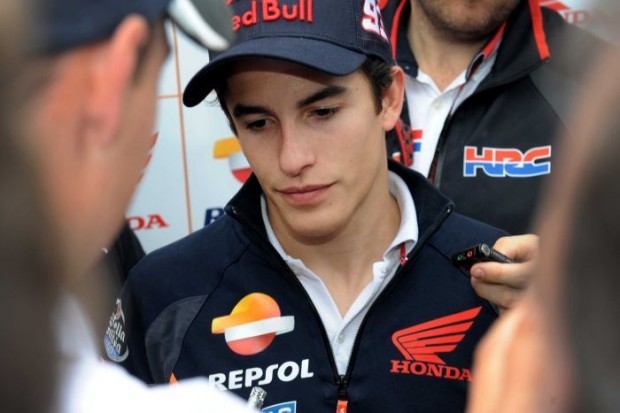
This is what disqualification looks like
If sanction is going to be applied, it needs to be consistent. The process needs to be transparent, as well as equitable. Ultimately, there needs to be a group of mature, intelligent adults on hand to assess situations as they arise, and take appropriate action. That has not been in evidence for some time. This is an industry with enormous variables, yet every time an issue arises, Dorna are incapable of dealing with it in a professional manner. Caramello the Clown, and his Spanish Dorna cronies grew up in the Franco era, and it would appear they learned about management from the General himself. What we see in MotoGP now is a dictatorial, irrational system of administration where regulations are changed arbitrarily and penalties applied with transparency, logic or avenue of appeal. Hence, it is becoming a circus.

All credit to a man fighting like hell to retain his championship
While the bulk of post-race analysis has focussed on apportioning blame for Marquez missing his pit window, it should not be forgotten that the whole debacle stems from Bridgestone supplying an inferior product that was incapable of satisfying the requirements of the teams they are contracted to supply. Instead of finding a way to address that problem, the sports administrators chose to interfere with the riders and regulations. Interfering in the sport can only result in the death of racecraft as we know it. If Dorna and its various partners continue to mismanage the sport in this manner, it is doomed. 2013 will go down as the worst Australian MotoGP ever.

In the aftermath of what was a shitfight of a race, there were two admirable displays of sportsmanship. Marc Marquez almost immediately took to social media to pre-empt the hate that was certain to erupt, and kept his enormous fan base focused on the positives. The second was from Jorge Lorenzo, who promptly claimed responsibility for the collision between himself and Marquez in turn one. It was a magnanimous act, because the haters had already begun piling scorn on Marquez to flog the ‘Marquez is dangerous’ dead horse further. Both men are incredible sportsmen, incredible motorcycle racers, and incredible men. The Dorna circus only does them injustice.




